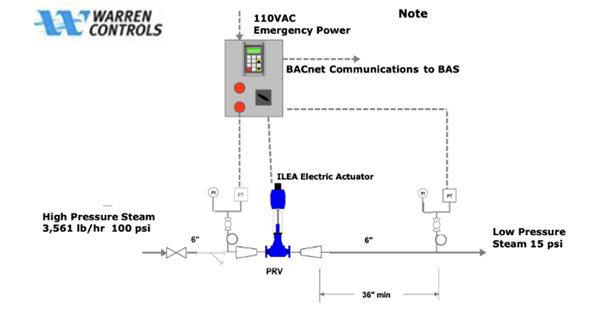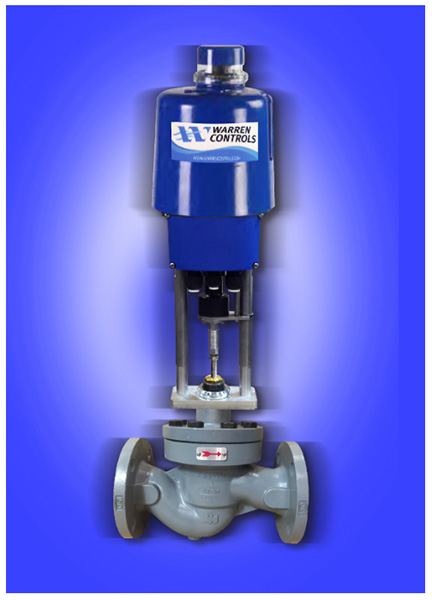Electric modulating pressure-reducing valves (PRV) are increasingly replacing traditional self-piloted regulators in steam systems.
By Robert Workosky, Warren Controls
A trend has been gaining steam. Electric modulating pressure-reducing valves (PRV) are increasingly replacing traditional self-piloted regulators in steam systems.
The adoption of this “smart” technology is part of the overall trend of digitally connecting all components to building automation systems (BAS) for greater visibility and control and for lower energy consumption.
Sometimes the shift to electric PRVs is driven by more basic considerations. For example, PRVs with electric actuators can be more compact, allowing them to fit in spaces too confined to install — and maintain — a pilot-operated steam regulator.
Moreover, an electric PRV can be set up to automatically calculate the downstream steam flow rate, without the need to install a traditional flow meter. This is an important benefit in locations that lack a sufficient straight run of pipe to accommodate a traditional flow meter.
Steam is usually produced at high pressure by a steam boiler, to avoid the production of wet steam among other reasons, and then distributed to one or more points of use that require lower pressure for safe and efficient operation. Steam pressure-reducing stations perform the critical function of reducing the pressure to a desired set point. The control of pressure can also be an effective means of controlling temperature because the temperature of saturated steam is closely related to its pressure.
A single facility may have several pressure reducing stations. Hospitals, for example, require PRVs to deliver steam for many different uses, including heating, humidification, hot water, sterilization, kitchen, and laundry functions, with varying steam usage requirements based upon the process, the time of day, weather, etc.
Pressure reducing stations also facilitate cost-effective distribution. Significantly smaller pipe diameter can be used where the steam is under high pressure. Therefore, on university campuses where the steam plant serves many buildings spread over a large area, the pressure reducing stations may be located close to the points of use to save on the installation cost of piping and fittings. This benefit needs to be weighed against the energy savings achieved from reducing radiant heat loss when distributing steam at lower temperatures.
The goal is not only to deliver steam below the maximum allowable working pressure (MAWP) of each piece of equipment, but to maximize energy efficiency for financial saving and environmental sustainability. The most significant energy savings from pressure reduction comes from delivering the optimal pressure at the point of use. Lower pressure results in increased enthalpy of steam and the availability of more latent heat. In other words, more BTUs can be delivered per pound of steam when the pressure is reduced.
Originally invented in the 1880s, pilot-operated steam regulators are a tried-and-true method of reducing steam pressure and flow. The main advantage is that they operate as self-contained devices that do not require electrical power or a pneumatic air supply. The operating principle is relatively straightforward: the valve operates by continuously balancing the downstream pressure (via a pressure-sending pipe) against a mechanical spring that operates in conjunction with a bellows or diaphragm. The pressure set point is adjusted by tightening or loosening bolts to increase or decrease the spring force.
Pilot-operated PRVs have several disadvantages inherent in their design. They provide a limited turndown ratio, typically 10:1. Therefore, it is quite common that multiple pilot-operated valves are installed in series, often in a 1/3 2/3 configuration, to produce the net pressure reduction required.
These devices are also prone to failure due to clogging by moisture and dirt in the small-diameter pressure sensing pipe and in the valve itself. Steam is used both as the sensing mechanism and as the force for moving the diaphragm.
The greatest advantage of pilot-operated valves — operation as a self-contained, isolated device — also serves as an important disadvantage. The ‘set-it-and-forget-it’ adjustments provide stable downstream pressure, but the pressure cannot be flexibly modulated based on changing load, weather, and other conditions.
Pilot-operated valves not only lack the ability to be intelligently controlled, but they are also unable to remotely communicate alerts of problem conditions or data on usage. In fact, a pilot-operated valve provides no visibility of its internal settings and operating condition even when you are standing in front of it.
Electric modulating PRVs employ an electric actuator to open and close the valve. Instead of the steam in a pressure-sending pipe used by a pilot-operated system, electronic PRVs utilize electrical signals. A controller continuously reads the downstream pressure and temperature from a sensor and uses this information to control the valve’s electric actuator.
Globe valves with electric actuators provide much more precise control than pilot-operated valves. They have a turndown ratio of 50:1 that supports low loads without the need for 1/3 2/3 configurations. The systems are more reliable and require less maintenance because the electrical connections eliminate the clogging problems of pilot sensing pipes. Globe valves are also more compact than pilot-operated regulators, making them suitable for confined spaces.

As a connected system, electric modulating PRVs are fundamentally different from standalone pilot-operated valves. In conjunction with sensors, controllers, and building automation systems (BAS), they offer new capabilities of visibility and control.
Visibility. The controller has constant visibility of the exact position of the valve. This information is useful in several ways. The pressure reduction station can be monitored remotely, generating alerts of fault conditions.
Steam usage data can be captured. The downstream flow rate can be calculated, using the orifice plate method, without installing a flow meter.
Control. The PRV can be precisely modulated, and automatically controlled by logic programmed into the local controller or the building automation system to optimize the system for energy efficiency or performance, and in emergencies, the PRVs can be controlled by personnel accessing the BAS remotely.
The ability to remotely monitor and control PRVs is especially useful when pressure-reducing stations are widely distributed at points of use through a large campus or facility and when the steam is used for several different processes.

As building automation systems become more commonplace, steam pressure-reducing stations are sometimes one of the last components to be integrated, long after chillers and boilers have been connected.
Electric modulating PRVs have proven to be highly reliable and easy to maintain while providing dramatically improved visibility and control that enables significant energy savings.
A college in New England installed a turnkey digital modulating PRV solution engineered by Warren Controls. The facility had a seasonal reduction of steam pressure from 60 PSIG in the fall/winter to 15 PSIG in the spring.
A Warren Controls ILEA Globe Valve with Electric Actuator was installed as a PRV after it was determined that a pilot operated pressure reducing valve would suffer poor downstream pressure control and potentially choke steam flow to the heating hot water set when in the late spring/early summer. Also, there was insufficient space for a pilot-operated PRV and insufficient straight run to accommodate a traditional flow meter.
Scott Ellyson, CEO of East West Manufacturing, brings decades of global manufacturing and supply chain leadership to the conversation. In this episode, he shares practical insights on scaling operations, navigating complexity, and building resilient manufacturing networks in an increasingly connected world.